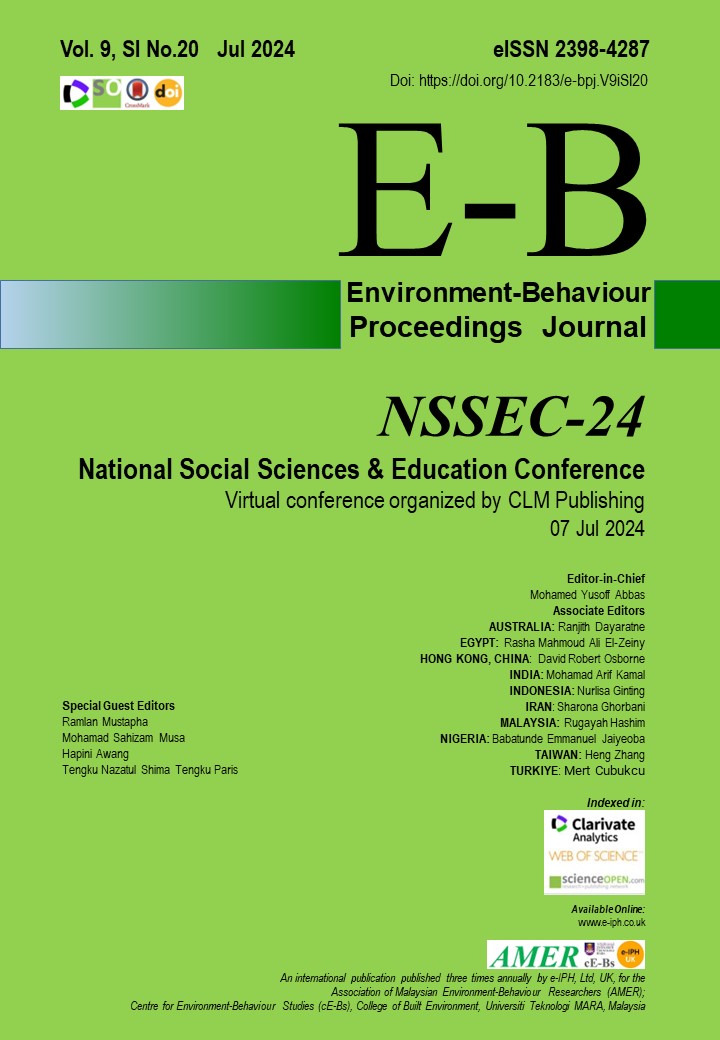Developing Crisis Coping Strategies using Nominal Group Technique for Psychological Distress Management
DOI:
https://doi.org/10.21834/e-bpj.v9iSI20.6096Keywords:
Nominal Group Technique, Crisis, Psychological Distress, Self-Coping StrategiesAbstract
This article solicits the opinions of seven professionals in the field of mental health in order to provide solutions for dealing with psychological crises through the application of the Nominal Group Technique (NGT). Four expert-approved approaches received acceptance scores between 90.48% and 100%. NGT facilitated quick and reliable validation of elements derived from literature reviews and expert consultations. Those working on individualised therapy modules for mental illness should be involved in future studies aimed at improving these approaches.
References
Abdul Aziz, A., Mohd Sukor, N., & Ab Razak, N. (2020). Wabak covid-19: Pengurusan aspek kesihatan mental semasa norma baharu. International Journal of Social Science Research, 2 (4), 156-174.
Aziz, A. R. A., & Musa, N. N. (2023). Pengurusan krisis rumah tangga dalam mencapai kesejahteraan. Malaysian Journal of Social Sciences and Humanities (MJSSH), 8 (1), e002168. https://doi.org/10.47405/mjssh.v8n1a3. DOI: https://doi.org/10.47405/mjssh.v8i1.2168
Abdullah, M. C., & Elias, H. (2018). Stress and coping strategies among postgraduate students: A review of literature. Journal of Student Affairs, 1 (2), 24-30.
Bennett, D., Sharpe, L., & Turner, A. (2019). Stress, coping, and psychological distress of postgraduate students. Journal of College Student Development, 60 (4), 431-438.
Caplan, G. (1964). Principles of preventive psychiatry. Basic Books.
Caplan, G. (1974). Theory and practice of crisis intervention support systems and community mental health: Lectures on concept development. Behavioral Publications.
Connelly, L. M. (2008). Pilot studies. Medsurg Nursing, 17 (6), 411. DOI: https://doi.org/10.12968/bjon.2008.17.7.29056
Delbecq, A. L., & Van de Ven, A. H. (1971). A group process model for problem identification and program planning. The Journal of Applied Behavioral Science, 7 (4), 466-492. https://doi.org/10.1177/002188637100700404. DOI: https://doi.org/10.1177/002188637100700404
Delbecq, A. L., Van De Ven, A. H., & Gustafson, D. H. (1975). Group techniques for program planning: A guide to nominal group and Delphi processes. Scott Foresman and Company.
Everly, G. S., Flannery, R. B., & Mitchell, J. T. (2000). Critical incident stress management (CISM): A review of the literature. Aggression and Violent Behavior, 5 (1), 23–40. https://doi.org/10.1016/s1359-1789(98)00026-3 DOI: https://doi.org/10.1016/S1359-1789(98)00026-3
Evans, T. M., Bira, L., Gastelum, J. B., Weiss, L. T., & Vanderford, N. L. (2018). Evidence for a mental health crisis in graduate education. Nature Biotechnology, 36 (3), 282-284. DOI: https://doi.org/10.1038/nbt.4089
Fox, W. M. (1989). The improved nominal group technique (INGT). Journal of Management Development, 8 (1), 20-27. https://doi.org/10.1108/eum0000000001331 DOI: https://doi.org/10.1108/EUM0000000001331
Fraenkel, J. R., Wallen, N. E., & Hyun, H. H. (2012). How to design and evaluate research in education (8th ed.). McGraw Hill.
Hertzog, M. A. (2008). Considerations in determining sample size for pilot studies. Research in Nursing & Health, 31 (2), 180-191. DOI: https://doi.org/10.1002/nur.20247
James, R., & Gilliland, B. (2001). Crisis intervention strategies (4th ed.). Brooks/Cole.
Kanel, K. (2012). A guide to crisis intervention (4th ed.). Brooks/Cole Cengage Learning.
Kumar, S., & Feldman, G. (2020). Psychological distress and academic adjustment of postgraduate students. International Journal of Educational Research and Reviews, 5 (3), 233-240.
Lomax, P., & McLeman, P. (1984). The uses and abuses of nominal group technique in polytechnic course evaluation. Studies in Higher Education, 9 (2), 183-190. https://doi.org/10.1080/03075078412331378834 DOI: https://doi.org/10.1080/03075078412331378834
MacPhail, A. (2001). Nominal group technique: A useful method for working with young people. British Educational Research Journal, 27 (2), 161-170. https://doi.org/10.1080/01411920120037117 DOI: https://doi.org/10.1080/01411920120037117
Mohamad Aziz Shah Mohamed Arip. (2010). Kesan kelompok bimbingan ke atas konsep kendiri, kelangsangan dan resiliensi di kalangan remaja [Doctoral dissertation, Universiti Kebangsaan Malaysia].
Mason, K. L., Thomas, E., Abraham, M. G., & Roshni, P. (2020). Exploring the relationship between psychological distress and personal crises among postgraduate students. Journal of Mental Health Counseling, 42 (1), 35-46.
Neale, I., Piggott, L., Hansom, J., & Fagence, S. (2016). Student resilience: Unite students insight report. Unite Students.
Robotham, D., & Julian, C. (2006). Stress and the higher education student: A critical review of the literature. Journal of Further and Higher Education, 30 (2), 107-117. DOI: https://doi.org/10.1080/03098770600617513
Samsiah Mohd Jais. (2020). Kesihatan mental dalam kaunseling. Penerbit Universiti Pendidikan Sultan Idris.
Tuckman, B. W., & Waheed, M. A. (1981). Evaluating an individual science programme for community college students. Journal of Research in Science Teaching, 18, 489-495. DOI: https://doi.org/10.1002/tea.3660180603
Qiu, J., Shen, B., Zhao, M., Wang, Z., Xie, B., & Xu, Y. (2020). A nationwide survey of psychological distress among Chinese people in the COVID-19 epidemic: Implications and policy recommendations. General Psychiatry, 33 (2), e100213. https://doi.org/10.1136/gpsych-2020-100213. DOI: https://doi.org/10.1136/gpsych-2020-100213
Downloads
Published
How to Cite
Issue
Section
License
Copyright (c) 2024 Siti Nordarma Ab Rahman, Nor Shafrin Ahmad

This work is licensed under a Creative Commons Attribution-NonCommercial-NoDerivatives 4.0 International License.





